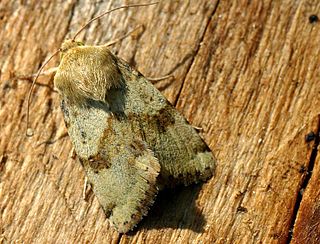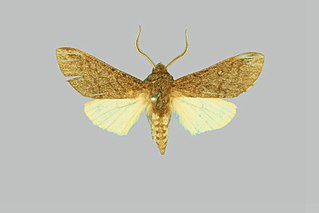Related Research Articles

Heliothis viriplaca, the marbled clover, is a moth of the family Noctuoidea. It is found in Europe and across the Palearctic to Central Asia then to Japan, Korea and Sakhalin. In the south, it penetrates to Kashmir and Myanmar. As a migratory moth, it also reaches areas in northern Fennoscandia in some years. North of the Alps, both indigenous and immigrant individuals occur in certain areas. The heat-loving species occurs mainly on dry grasslands, fallow land, heathlands and sunny slopes and slopes and the edges of sand and gravel pits.

Hopliocnema is a genus of moths in the family Sphingidae, containing only one species, Hopliocnema brachycera, which is known from Queensland, Victoria and New South Wales.
Cibyra ferruginosa is a species of moth of the family Hepialidae. It was described by Francis Walker in 1856 and is known to live in the northeastern region of Brazil.
Cosipara delphusa is a moth in the family Crambidae. It was described by Herbert Druce in 1896. It is found in Mexico and Guatemala.
Nites grotella, the hazel leaftier moth, is a moth in the family Depressariidae. It was described by Robinson in 1870. It is found in North America, where it has been recorded from Nova Scotia to New York, as well as in Manitoba and Ontario.
Thiotricha sciurella is a moth of the family Gelechiidae. It was described by Walsingham in 1897. It is found on the West Indies and from Mexico to Brazil.
Chlamydastis chionoptila is a moth of the family Depressariidae. It is found in Brazil.
Antaeotricha fulta is a moth of the family Depressariidae. It is found in Colombia.
Antaeotricha tremulella is a species of moth of the family Depressariidae. It is found in the Guianas and Brazil.
Paralecta electrophanes is a moth in the family Xyloryctidae. It was described by Edward Meyrick in 1930. It is found in Malaysia.
Doina asperula is a moth in the family Depressariidae. It was described by John Frederick Gates Clarke in 1978. It is found in Chile.
Revonda is a monotypic moth genus in the family Oecophoridae. Its only species, Revonda eschara, is found in Chile. Both the genus and species were described by John Frederick Gates Clarke in 1978.
Antaeotricha discolor is a moth in the family Depressariidae. It was described by Lord Walsingham in 1912. It is found in Mexico (Guerrero) and Guatemala.
Antaeotricha fumifica is a moth in the family Depressariidae. It was described by Lord Walsingham in 1912. It is found in Mexico.
Antaeotricha machetes is a moth in the family Depressariidae. It was described by Lord Walsingham in 1912. It is found in Mexico (Guerrero).
Antaeotricha ostodes is a moth in the family Depressariidae. It was described by Lord Walsingham in 1913. It is found in Guatemala.
Antaeotricha catharactis is a moth in the family Depressariidae. It was described by Edward Meyrick in 1930. It is found in Brazil.
Antaeotricha chalinophanes is a moth in the family Depressariidae. It was described by Edward Meyrick in 1931. It is found in Bolivia.
Stenoma epicta is a moth in the family Depressariidae. It was described by Lord Walsingham in 1912. It is found in Tabasco, Mexico.
Chlamydastis crateroptila is a moth in the family Depressariidae. It was described by Edward Meyrick in 1918. It is found in French Guiana.
References
| This article on a moth of the tribe Gnorimoschemini is a stub. You can help Wikipedia by expanding it. |